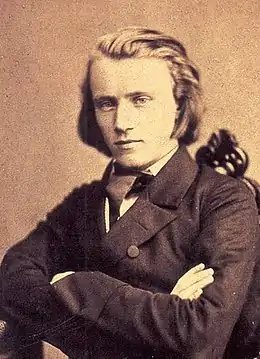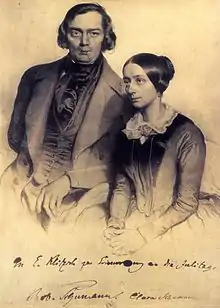

"Die Blümelein, sie schlafen" is the first line of the German lullaby "Sandmännchen" (Sandman), from Anton Wilhelm von Zuccalmaglio's collection Deutsche Volkslieder (1840). The melody is based on a French song from the late 1500s which was also used for the Christmas carol "Zu Bethlehem geboren" (1638) to a text by Friedrich Spee.
A sandman is a mythical figure in German and other European folk tales who sprinkles sand in the children's eyes at night, making them drowsy and inspiring beautiful dreams.
Johannes Brahms wrote a piano accompaniment for this song in 1858 as no. 4 in his collection 15 Volkskinderlieder (15 Folk Songs for Children), WoO 31.[1] He dedicated this collection to the children of Robert and Clara Schumann.[2]
Text
Die Blümelein, sie schlafen
schon längst im Mondenschein,
sie nicken mit den Köpfen
auf ihren Stengelein.
Es rüttelt sich der Blütenbaum,
er säuselt wie im Traum:
Schlafe, schlafe, schlaf du, mein Kindelein!
Die Vögelein, sie sangen
so süß im Sonnenschein,
sie sind zur Ruh gegangen
in ihre Nestchen klein.
Das Heimchen in dem Ährengrund,
es tut allein sich kund:
Schlafe, schlafe, schlaf du, mein Kindelein!
Sandmännchen kommt geschlichen
und guckt durchs Fensterlein,
ob irgend noch ein Liebchen
nicht mag zu Bette sein.
Und wo er nur ein Kindchen fand,
streut er ihm in die Augen Sand.
Schlafe, schlafe, schlaf du, mein Kindelein!
Sandmännchen aus dem Zimmer,
es schläft mein Herzchen fein,
es ist gar fest verschlossen
schon sein Guckäugelein.
Es leuchtet morgen mir Willkomm
das Äugelein so fromm!
Schlafe, schlafe, schlaf du, mein Kindelein![3]
The little flowers are sleeping
Already well under the moonlight,
They bow their heads
On their stems.
The flower tree is rustling,
It whispers as in a dream:
Sleep, sleep, you sleep, my little child.
The little birds, they warbled
so sweetly in the sun,
they have gone to slumber
in their little nests.
The cricket on the blade of grass,
Only he coos softly:
Go to sleep, go to sleep, my precious child!
The sandman comes creeping
and peaks through the window,
to see if still a child
might not yet be in bed.
And where he finds even one child,
he scatters the sand in his eyes.
Go to sleep, go to sleep, my precious child!
The sandman exits from the room,
my darling sleeps so well,
his eyes are shuttered firmly,
quite tightly locked the lids.
The welcome dawn illuminates
those little eyes so pure!
Go to sleep, go to sleep, my precious child!
Melody
![\header { tagline = ##f }
\layout { indent = 0 \set Score.tempoHideNote = ##t
\context { \Score \remove "Bar_number_engraver" }
\context { \Voice \remove "Dynamic_engraver" }
}
global = { \key g \major \time 4/4 \partial 4 }
kords = \chordmode { \global
\repeat volta 2 { s4 | g,1 | g,2 d,2 | d,2 g,2 | d,2 s4 }
s4 | g,1 | c,1 | d,2:7 g,2 | d,2. s4
g,2 d,2 | g,1 | g,2 d,2 | g,2 s4
}
melody = \relative c' { \global
\repeat volta 2 {d4\p g4. a8 b4 a | \acciaccatura a8 g2 fis4 g | a8 (b8) c4 b8 (a) g4 | a2 r4 }
b8\mf (c) | d4 b c d | e4. d8 c4 a8\p (b) | c4 c b d | a2. r4
\tempo 4 = 102 d4.\pp (b8) a2 | b4. (a8) g [(a)] \tempo 4 = 96 b\ppp (c) | d4 \tempo 4 = 88 g,8 (a) b4 a | g2 r4 \bar "|."
}
verse = \lyricmode {
Die Blü -- me -- lein, sie schla -- fen
schon längst im Mon -- den -- schein,
Es rüt -- telt sich der Blü -- ten -- baum,
er säu -- selt wie im Traum:
Schla -- fe, schla -- fe, schlaf du, mein Kin -- de -- lein!
}
verseR = \lyricmode {
sie ni -- cken mit den Köp -- fen
auf ih -- ren Sten -- ge -- lein.
}
chordsPart = \new ChordNames {
\set Staff.midiInstrument = #"acoustic guitar (steel)"
\set Staff.midiMinimumVolume = #0.3
\set Staff.midiMaximumVolume = #0.3
\set chordChanges = ##t \kords
}
melodyPart = \new Staff \with { midiInstrument = "flute"}
{ \clef "treble" \melody }
\score {
<<
\chordsPart
\melodyPart
\addlyrics { \verse }
\addlyrics { \verseR }
>>
\layout { }
}
\score { \unfoldRepeats { << \chordsPart \\ \melodyPart >> }
\midi { \tempo 4=112 }
}](../I/0716347d21cfee34b9c1ecaa74805e39.png.webp)
References
- ↑ 15 Volkskinderlieder, WoO 31 (Brahms): Scores at the International Music Score Library Project, incl. "No. 4 'Sandmännchen' "
- ↑ Fuller-Maitland, John Alexander (1895). Masters of German Music. Masters of Contemporary Music. New York: Charles Scribner's Sons. p. 64.
- ↑ Text and links to English and other language translations, LiederNet Archive
External links
- "Sandmännchen" (Johannes Brahms): Free scores at the Choral Public Domain Library (ChoralWiki)
- "Sandmännchen": Free scores at the Choral Public Domain Library (ChoralWiki), TTBB 4-part setting by Ernst Rudorff
- "Die Blümelein, sie schlafen", children's lullaby on YouTube
- Brahms accompaniment (video) on YouTube, Melanie Forgeron (soprano), Edward Rushton (piano)